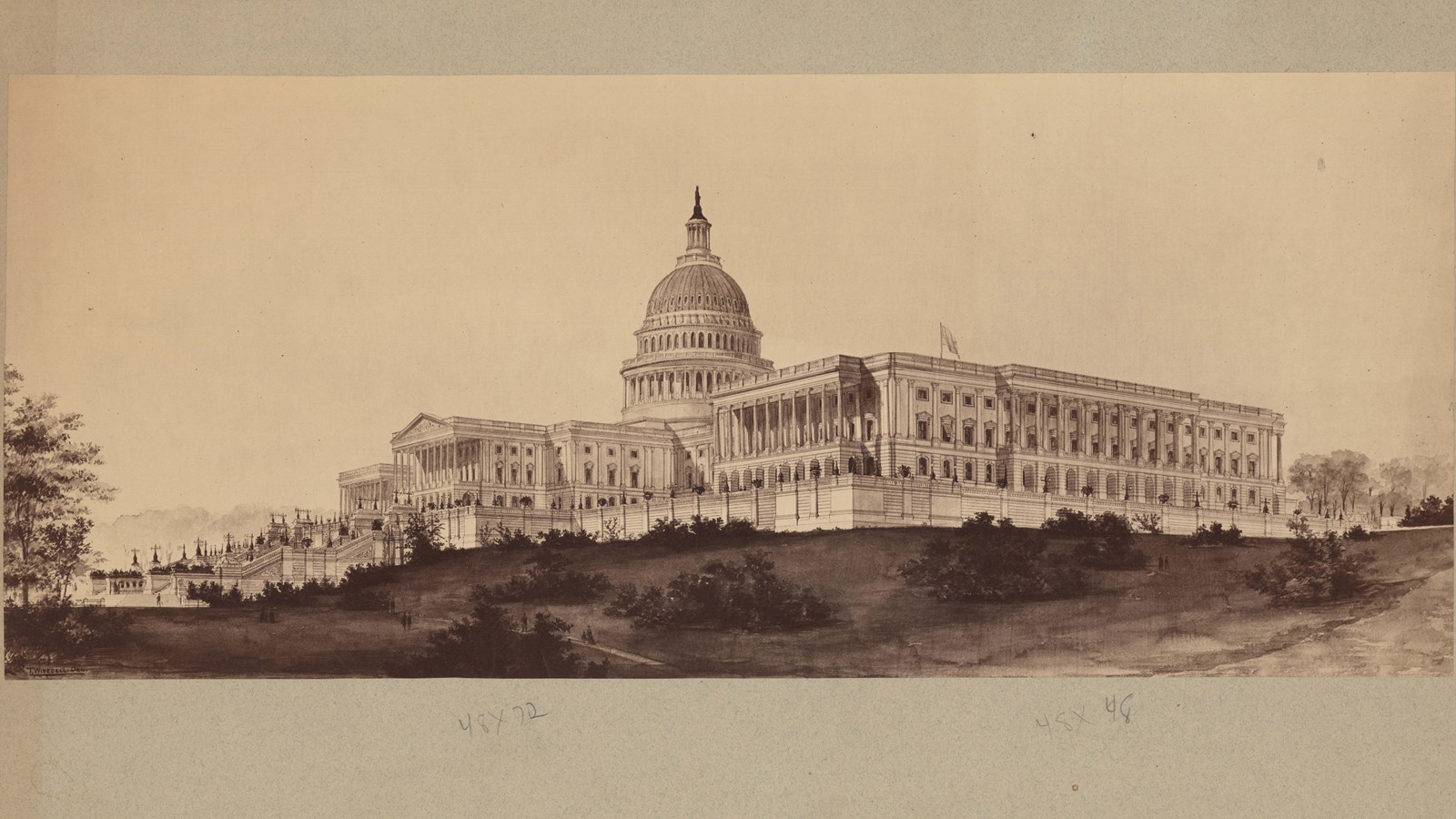Last updated: June 12, 2024
Place
U.S. Capitol Grounds

Olmsted Archives
Quick Facts
Location:
Washington, D.C.
Significance:
Olmsted Designed Landscape
MANAGED BY:
The Capitol we see today underwent extensive expansion in the mid-19th century, and who else to plan and oversee that work but Frederick Law Olmsted.
In 1874, with the additions of House and Senate wings, as well as a new dome, the grounds surrounding the Capitol also needed to be enlarged. Describing his plan for the Capitol, Olmsted said that “the ground is in design part of the U.S. Capitol, but in all respects subsidiary to the central structure.”
To not detract attention away from the Capitol Building, Olmsted was careful not to group any trees or other landscape features together. He also strongly believed that the use of sculptures and other ornamentations should be kept to a minimum.
While Olmsted was determined to have the grounds compliment the building, he also felt the need to address architectural problems that had persisted for years. Washington, D.C. was expanding west, and the terraces of the Capitol Building did not seem to support that notion. Olmsted proposed marble terraces on the sides of the building to “gain greatly in the supreme qualities of stability, endurance, and repose.”
Work accelerated in 1877, both on the building and the grounds. Olmsted employed over 100 varieties of trees and bushes at the Capitol, with thousands of flowers used in seasonal displays. In 1878, after hundreds of flowers had been destroyed or stolen by vandals, watchmen were appointed to patrol the grounds and proved quite effective, allowing the lawns to be completed.
In 1885 Olmsted retired as superintended of the terrace project, though he continued to direct work on the grounds until 1889. His goal in working on the Capitol was not to detract from the building but compliment it with the grounds. He did so by contrasting the buildings straight lines with the curved walkways of the grounds, the same grounds a bill must walk in the hopes to become a law.
Source: "U.S. Capitol Grounds," The Cultural Landscape Foundation
For more information and primary resources, please visit:
Olmsted Research Guide Online
Olmsted Archives on Flickr
Olmsted Online
In 1874, with the additions of House and Senate wings, as well as a new dome, the grounds surrounding the Capitol also needed to be enlarged. Describing his plan for the Capitol, Olmsted said that “the ground is in design part of the U.S. Capitol, but in all respects subsidiary to the central structure.”
To not detract attention away from the Capitol Building, Olmsted was careful not to group any trees or other landscape features together. He also strongly believed that the use of sculptures and other ornamentations should be kept to a minimum.
While Olmsted was determined to have the grounds compliment the building, he also felt the need to address architectural problems that had persisted for years. Washington, D.C. was expanding west, and the terraces of the Capitol Building did not seem to support that notion. Olmsted proposed marble terraces on the sides of the building to “gain greatly in the supreme qualities of stability, endurance, and repose.”
Work accelerated in 1877, both on the building and the grounds. Olmsted employed over 100 varieties of trees and bushes at the Capitol, with thousands of flowers used in seasonal displays. In 1878, after hundreds of flowers had been destroyed or stolen by vandals, watchmen were appointed to patrol the grounds and proved quite effective, allowing the lawns to be completed.
In 1885 Olmsted retired as superintended of the terrace project, though he continued to direct work on the grounds until 1889. His goal in working on the Capitol was not to detract from the building but compliment it with the grounds. He did so by contrasting the buildings straight lines with the curved walkways of the grounds, the same grounds a bill must walk in the hopes to become a law.
Source: "U.S. Capitol Grounds," The Cultural Landscape Foundation
For more information and primary resources, please visit:
Olmsted Research Guide Online
Olmsted Archives on Flickr
Olmsted Online
